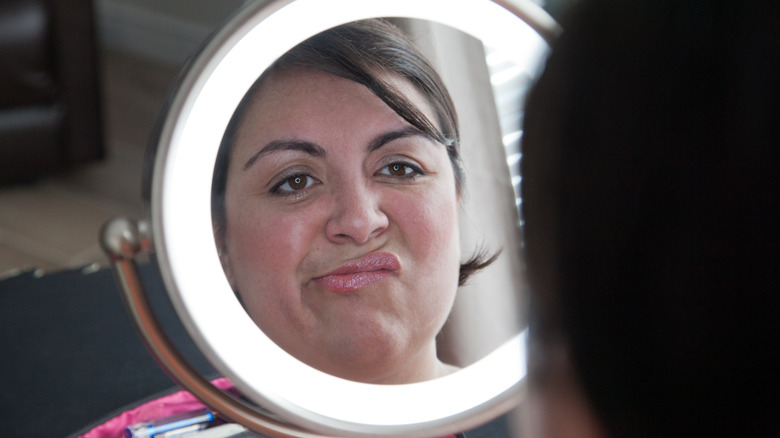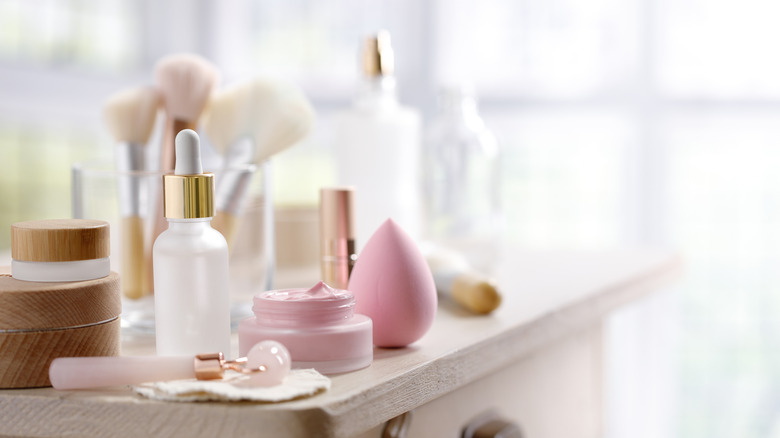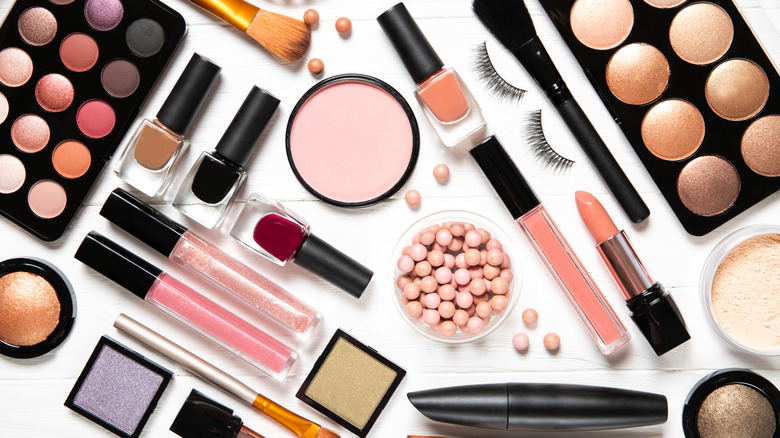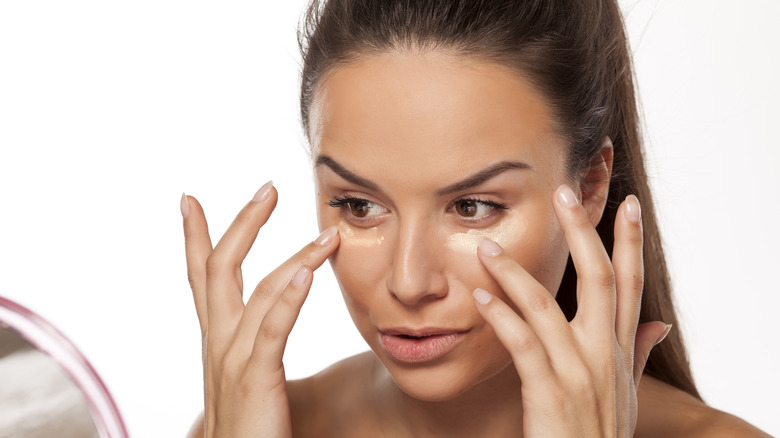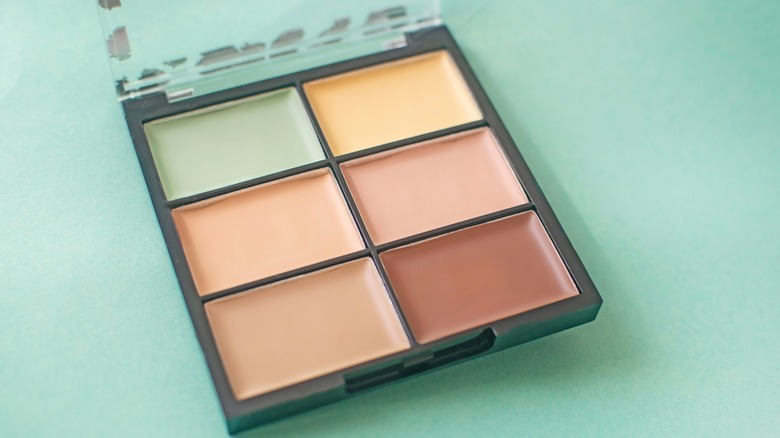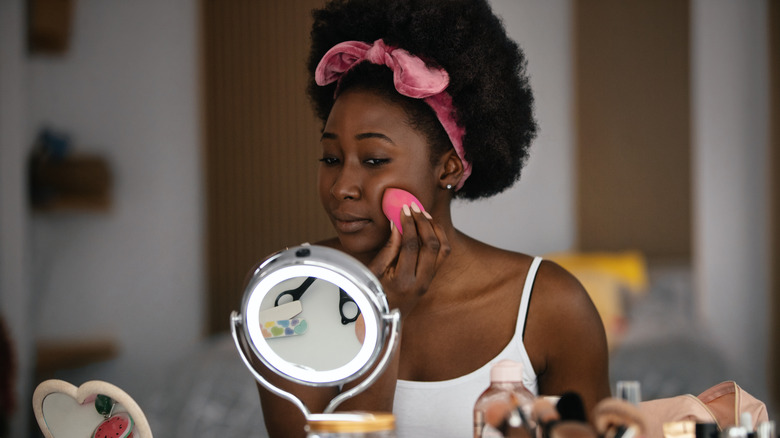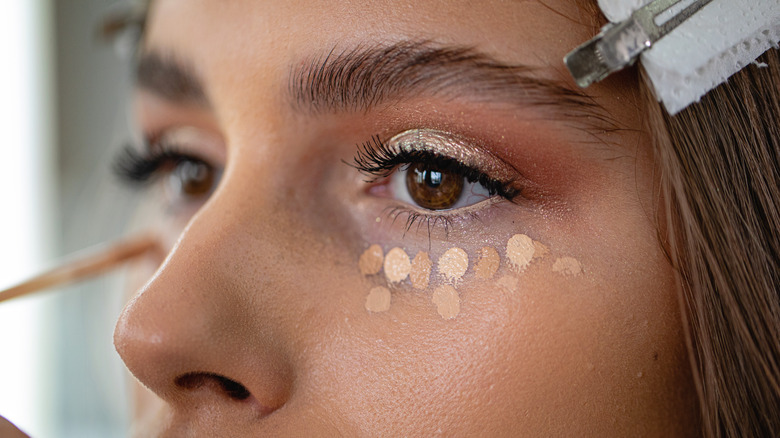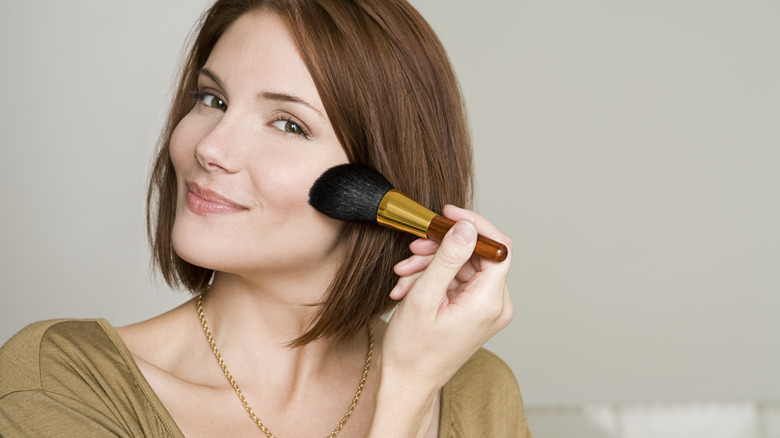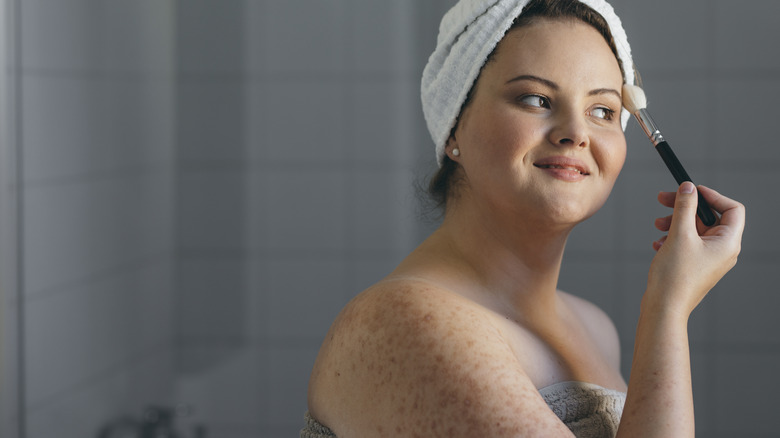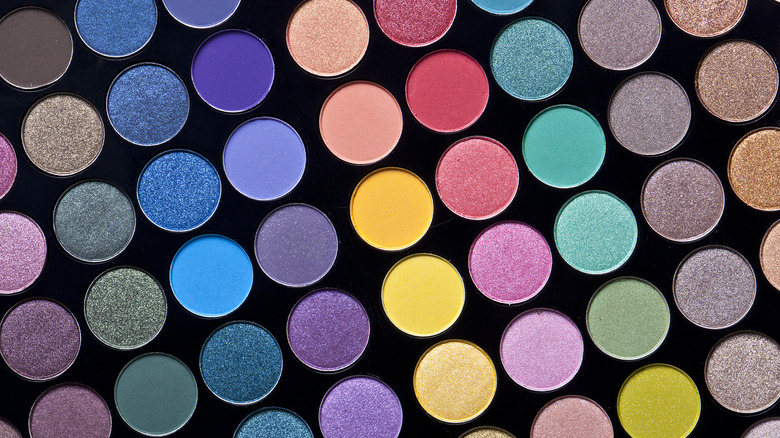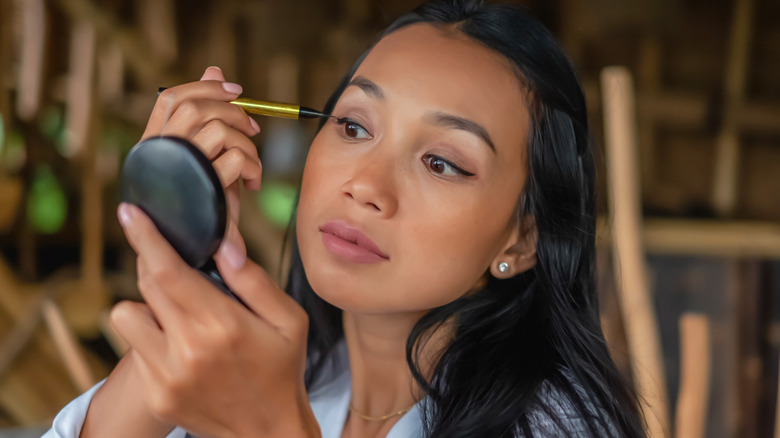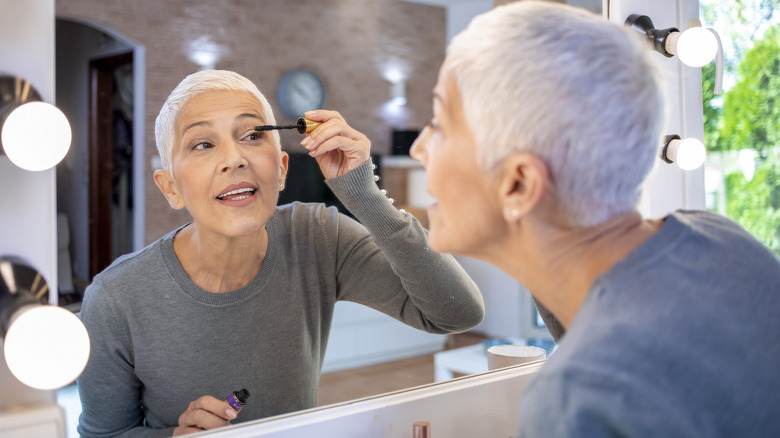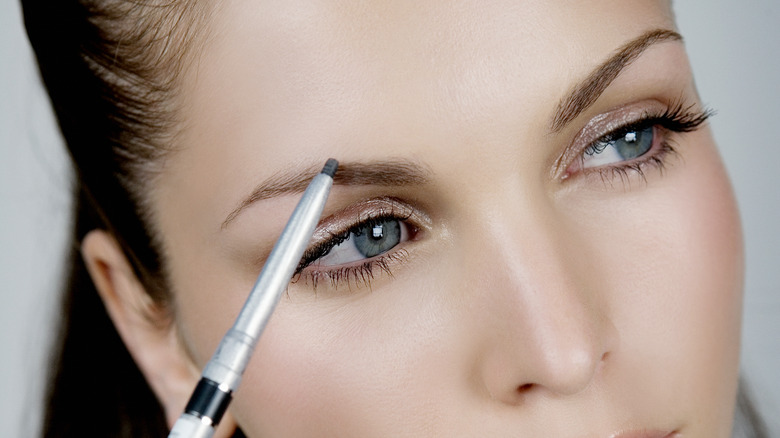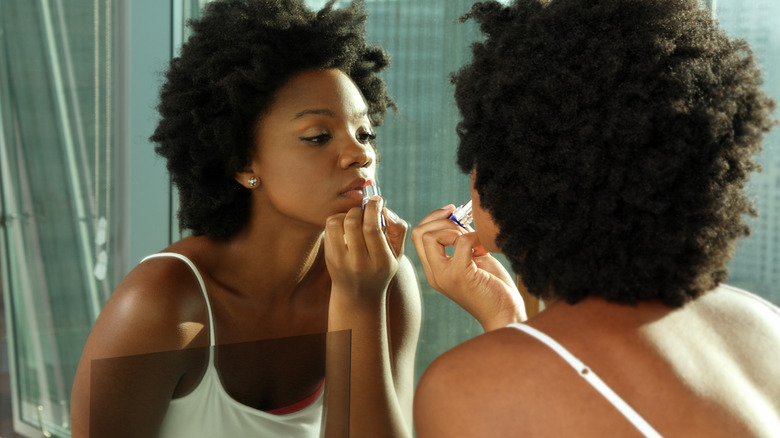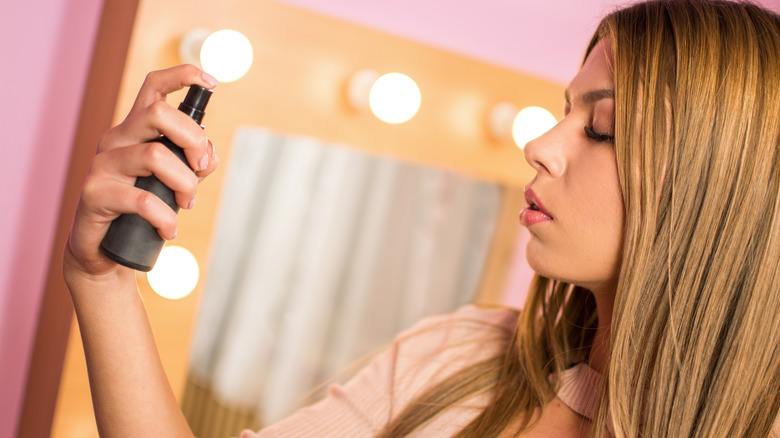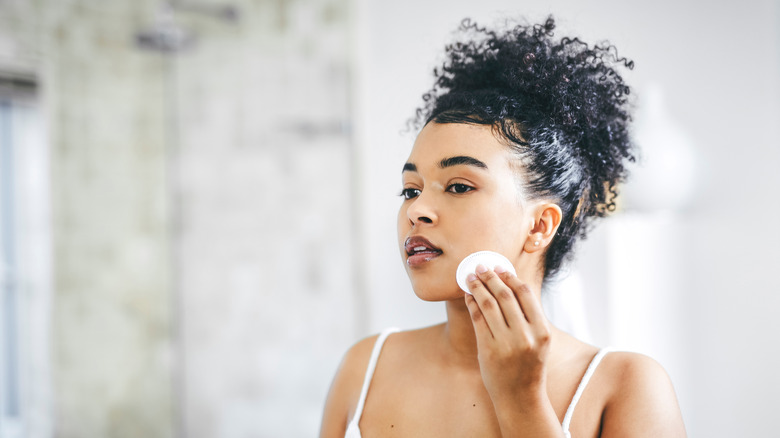How To Wear Makeup If You Hate Wearing Makeup
There are so many reasons you may not like to wear makeup. For one thing, it can be time-consuming to put it on, even if you're only doing the basics. People with sensitive skin may dislike trying to find products that don't make them break out or feel itchy. Plus, makeup isn't cheap, and the products that have the best ingredients tend to be more costly (although that's not always the case, but you'll then have to put time into researching the best products). And some folks are simply happy with how they look sans makeup.
There are times, however, that you may want to wear makeup, even if you hate it. Perhaps you have a blemish that needs to be covered, or you're taking part in a friend's wedding and they've requested that everyone in the bridal party wear makeup. Some jobs might even ask that employees wear makeup if they're in front of customers, especially if they're working in a store or department that's selling makeup. Maybe you're just wanting to feel a little differently. There's a thing called the "red lipstick effect," where just a little color on your lips is said to attract more attention and thereby boost your confidence. Even if it's just some eyeliner and lipstick, a little makeup can go a long way, so here's how to wear it if you're not a big fan.
Before you start wearing makeup
If you absolutely abhor makeup, don't wear it. Makeup is and should be a personal choice. Now, if you decide you want to give makeup a try because your dream job requires it or your bestie really, really wants you to wear makeup as her bridesmaid, then that's a choice you can make on your own. When considering wearing makeup as someone who isn't a fan, you'll want to start off by doing a little research on which products to use. Consider factors like your skin type, coloring, and preferences. You can watch videos on YouTube and TikTok for tips on application. Most importantly, before you apply makeup, you want to start with a clean canvas — so wash your face. You may also want to apply a moisturizer to help combat dry skin that can become even more apparent once you add makeup.
And keep in mind that there are times when you may not want to — and shouldn't — wear makeup. According to Dr. Paul Jarrod Frank, makeup is a no-go after facial treatments like micro-needling, and he advises to skip the beauty products when you're going to the gym or plan to be in other sweat-inducing environments. "If you're sweating excessively while wearing makeup, you're creating mud on the face," he told Byrdie. And that mud-like substance can lead to clogged pores and breakouts.
What tools you'll need for wearing makeup
Makeup application is about more than just picking the right colors, so before you start applying (or shopping), consider the tools you'll need. From sponges to brushes, each makeup product has its own application process. While you can apply eyeshadow with your fingers, brushes can help put multiple colors on smoothly and allow for easier blending. Sponges will assist in helping your foundation look even and less streaky.
There are a plethora of makeup brushes, but according to makeup artist Bobbi Brown's MasterClass, the main ones you'll want to have on hand are a concealer brush, at least one brush for your eyeshadow (or perhaps one for each color you intend to use), a blush brush, and a brush for your eyeliner if you're not using a pencil. You may also need an eyeliner sharpener if you're using a pencil. While your sponges will help you get your primer and foundation into place, you may also want a puff for applying powder, or a fluffy brush. If you're diving into the deep end and doing contouring, contouring brushes are a must. A spoolie brush and an eyelash curler can round out your tool collection.
Decide if you need a primer
If you've ever done any house painting, you know that primer can cover flaws so that your paint goes on smoothly. That's the same basic concept for skin primer. Makeup artist Lindsey Trop told Byrdie, "Whether you have dry skin, oily skin, dull skin, are concerned about acne, hyperpigmentation, sun protection, pollutants, or have multiple concerns, there is a primer out there for you." And these are just some of the reasons you may want to start with primer before you put on your makeup. Yes, it's one more step, but it has its benefits.
Primer can help your makeup stay in place longer. As makeup artist Juliette Perreux explained to Byrdie, "Special occasions [like a wedding] bring about tears, sweat, and lots of hugging and kissing, so a primer can be super helpful to keep everything in place and from smudging or moving around." So, if you need staying power, primer isn't a step to skip. However, if you don't feel you need it, then nix it.
When to consider a color corrector
Here's another step that you may be able to skip. If you're begrudgingly putting on makeup, you may not care whether your skin tone is even or not. If there's some other reason you're opting to wear makeup even though you hate it, you may be interested in what a color corrector can do for you.
"Color correctors are really used if there's any discoloration on someone's face, whether it's under eye bags, discoloration, rosacea, or if they have any acne scars," makeup artist Dani Parkes told Marie Claire. With that in mind, if this doesn't describe you, you can completely skip this step. However, if it does apply to you, you'll want to know which colors are best for correcting which issues. As Parkes described, "Green will cancel out redness, but red will cancel out purple, which is very common under the eyes."
Pick the right foundation for you, or skip it
When it comes to foundation, the first thing you want to decide is if you even want to wear it. While it makes a nice canvas for your makeup, a tinted primer can do the same thing, so you don't need both. However, there are also different types of foundation, providing light to full coverage. If you want a natural look, opt for light. If you want to look like you're about to walk down the runway and feel like altering your look in a major way, pick a fuller coverage foundation. A tinted moisturizer is another excellent choice in place of foundation if you're not looking for full coverage.
If you do want to wear foundation, you'll need to pick the right tone for your face. To test colors, you can put a swatch on your arm, as makeup artist Allen Avendaño told InStyle. "This doesn't have to be an exact match, but maybe slightly lighter because the color is going to shift throughout the day," he explains. "Foundation oxidizes with wear, and naturally gets darker with the mixture of elements and the oils on your face."
Apply concealer if you choose to
If you're battling blemishes or dark circles under your eyes, concealer may be something you want on your makeup menu. You can use this makeup product even if you don't apply foundation first. It's also handy to use when you're not using a full-coverage foundation. As celebrity makeup artist Nydia Figueroa told Elle, "Concealer is going to hide hyperpigmentation, redness, and any other discoloration to the skin that foundation alone won't cover. It has more coverage than a regular foundation and certain formulas are buildable and vary by skin type."
You might want to invest in two different shades of concealer — one that is a shade lighter than your foundation, and one that is a shade darker. This is because the color of our skin can change some depending on how much or how little time we spend getting any sun exposure. If you spend a lot of time outside in the summer, that darker shade of concealer will come in handy.
Go easy on the blush
Blush gives our cheeks a healthy, rosy glow, but there are times when we want to wear more or less of it. If makeup isn't your forte, and you don't have a desire for it to be, you may want to go with the lightest bit of blush for a natural look. "Think of blush as that essential tool that can define the overall look of your make-up," Nars global artistry director Uzo told Vogue. "When used to add a pop of color on the apples of the cheek, skin tends to look more natural and flushed. When swept along the cheekbones to create contour, the face is given additional dimension and structure for a more refined finish."
In addition to powder blush, there are cream formulations that you can apply with clean fingers. These formulas tend to have a lightweight finish that looks very natural, perfect for anyone who doesn't want to appear too made up.
Feel free to skip bronzer and highlighter
If you are not much for wearing makeup and simply want a quick, natural look to get through whatever it is that's inspiring you to wear makeup, you can skip these two products. Highlighters and bronzers are most often used to contour, a makeup technique used to change how the shape of your face appears. It's not a necessary step unless you want it to be. If you do want to go all the way, you can — or you can simply give yourself a sunkissed look with bronzer (if you have some on hand).
"Bronzer is always an option to use as a contouring product," celebrity makeup artist Lisa Aharon told Makeup.com. "Just steer clear of anything with shimmer or shine, as it won't create the contouring effect properly." For a full-tanned look, however, opt for Aharon's advice of using bronzer all over your face: "Either layering it on top of your foundation or on its own," she said.
Pick eyeshadow that matches your eyes
The eyes are the window to the soul, so why not make yours pop a little more with just the right choice of eyeshadow color? There are shades of eyeshadow for nearly every single color under the sun, and then some. If you want to go with a no-makeup makeup look, skip the eyeshadow altogether, or go with a light, neutral shade, like something in the tan or peach family.
If you want a more subtle look to ease into wearing makeup, we suggest picking colors that highlight the natural color of your eyes. If you have hazel eyes, use browns and greens, while warm browns and golden tones are great for brown eyes. Teal eyeshadow can highlight blue or green eyes. If you want to make your eyes the focal point of your look, you can also use complementary colors to make your eyes more prominent. "On a color wheel, you can find your specific eye color and directly across from that color will be the complementary shade for your own eye color," professional makeup artist Melissa Hurkman told Vogue.
Consider eyeliner
Eyeliner does a couple of different things, in addition to making your eyes stand out. Applied in certain ways, eyeliner can make small eyes look bigger, change the overall appearance of the shape of your eye, as well as make your lashes look fuller without mascara. "If your eyes are narrow, you will only want to add liner to the outer half and extend the line to create more length on the outer edges," Nikki DeRoest, Bobbi Brown's Artist in Residence, told Who What Wear. She added, "If you have almond eyes, most eyeliner shapes and looks will be complementary."
As far as picking a liner color, basic black is always an excellent choice, but you can also opt for a shade that matches your hair. Use a pencil for easy application, as liquid liners can sometimes take some getting used to. Of course, if you love your eyes just the way they are, you can easily skip the eyeliner and still look great. You can play with colors below your eye or use eyeshadow as a soft liner, as well, to get a different look.
Use mascara to make lashes look longer and thicker
Mascara has a way of bringing your eyes to the forefront of your makeup routine, and it's as easy as the swipe of a wand. As president and creative director of Anastasia Beverly Hills Claudia Soare told Today, "Mascara enhances the eyes in a number of ways. It not only darkens lashes, but can lengthen and volumize for brighter, bigger-looking eyes. Fuller-looking lashes can help to give a more youthful appearance to the eye area." Of course, there are different types of mascara. Some are made to lengthen, some to curl, and others that will make your lashes look thicker.
In defense of not wearing this makeup staple, the "no mascara" trend was a thing a few years back, and we truly believe you could be the one to bring it back again. There are plenty of reasons to skip mascara: It can sometimes go on clumpy and sticky, and if you don't give it enough time to dry, it could come off below or above your eyes when you blink. Some people just don't like the feel of it. Mascara is also prone to bacteria build-up, so your tube needs to be replaced every few months, according to the U.S. Food and Drug Administration.
Focus on your eyebrows
Doing your eyebrows may be the answer to dealing with putting on makeup when you hate to. "A little bit of filling in can make you look more awake," brow expert Sarah McQuarrie told Good Housekeeping. "[Doing your brows] can make you look more alert, a little bit younger, a little fresher, and you can do a little bit less makeup overall."
The basic tools that will get you to fuller and brighter brows are an eyebrow pencil and a spoolie brush. You can also use eyebrow powders and other tools to add shape and color to your brows. When it comes to picking the best color for this area of your face, keep in mind McQuarrie's advice: "Your brows are typically darker than the hair on your head." One shade darker is likely to be a good choice, whether you're using gel, powder, or a pencil to shape and color them.
Lips don't always require lipstick
Makeup artist Tara Dowburd told Reader's Digest, "Wearing lipstick — whether sheer, metallic, matte, creamy, liquid, opaque, long-wear, glossy, or a stain — makes us feel pretty, as well as confident and put together." You can go with no color at all, but if you're opting for something with a slight color or tint, a lip balm works well. However, we think your lips offer one of the best canvases to easily play around with color. Even if you hate putting makeup on anywhere else, lipstick can give your entire face a boost of color. If you don't want a solid coat of lipstick, a gloss or balm are great alternatives. For solid colors, lip stains and lip crayons work as well.
Dowburd also pointed out one important fact: "A lipstick color will look different on various skin tones, because of the undertone of your skin color, so you want to try the lipstick on your lips (nowhere else) and in the best natural light possible."
Should you finish with a setting spray or powder?
Much like primer, setting sprays and powders help keep your makeup in place longer. If you want your look to stick around for the entire day, from office to nighttime activities, finish things off with a setting spray. If you're not concerned with makeup that stays in place all day, skip this step and save yourself some money.
If you're trying to pick the right setting spray, follow celebrity makeup artist Bryan Cantor's guidelines. He told Real Simple: "Those with oily, normal, or combination skin types should use matte or waterproof sprays ... You should still finish oilier areas with powder to help prevent shine ... Those with dry skin can use waterproof or dewy setting sprays, but may still want to use a hyaluronic powder on the forehead, under the eyes, and on the sides of the nose for finish."
How to remove makeup
Removal of your makeup is very important to help keep your skin healthy. Even if you're only wearing a little bit, you'll still want to clean it off before bed. While you can invest in products specifically made for cleaning off your makeup, it's not totally necessary. "Don't underestimate the power of a cleanser that doesn't necessarily get marketed as specific makeup remover," dermatologist Kavita Mariwalla told Well + Good. "The principle behind removing anything on the skin — whether it is dirt or makeup is that 'like dissolves like' so oil-based cleansers will remove thicker makeup and a regular cleanser will do enough to remove light makeup."
If you already have a regular face cleaning routine, try those products out first and see if they remove everything. This can save you some time and money. These days, many people use micellar water as their makeup remover. "Micelles themselves pick up the oily makeup and incorporate them into their structure, which can then be wiped away with a cotton ball," said Dr. Mariwalla — easy peasy!
